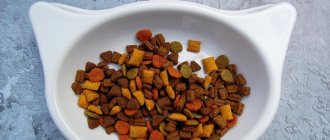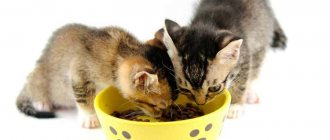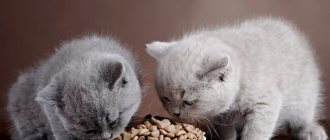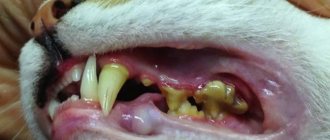Advantages of dry industrial feed
Most people prefer to feed their pets ready-made store-bought food - dry food and wet canned food. Granules have been the winner for many years, as they have many advantages:
- Economical . If you choose economy and premium food for your kitten, they will not put a strain on the family budget. But there are exceptions in this category - holistic and super-premium food. Their price is quite high.
- Convenience for the owner and saving time . Feeding kittens, and even adult animals, human food from a common table is strictly prohibited. When choosing a natural diet, the baby will have to cook separately every day, cook porridge, freeze lean meat in advance, and grate vegetables. A working person simply does not have time for this. Dry food for those who are away from home for a long time or often leave for several days is a real salvation.
- There is no need to strictly follow the feeding regime . Natural products should not be left in a bowl for a long time, especially during the hot season. They spoil quickly and can cause food poisoning in the animal. Dry granules can remain in the bowl for several days. They will not spoil or lose their taste.
- Benefit. High-quality food contains vitamins and minerals, as well as microelements beneficial for the kitten. Proteins, fats and carbohydrates are perfectly balanced. When giving your pet natural food, you should independently monitor the balance of all elements and additionally give vitamin complexes.
Dry food is very healthy and easy to use, the main thing is to properly accustom the kitten to a new type of food.
Feed composition
It should be understood that the ready-made menu for cats is made from hydrolyzed meat. In addition to this, the composition must include:
- dried vegetables;
- mixture of cereals;
- medicinal herbs;
- mineral supplements;
- complex of vitamins.
It is clear that it is impossible to provide such variety by feeding a pet from a common table. The kitten may refuse vegetables, turn away from cereals, and he doesn’t like medicinal herbs at all.
Dry food has a pleasant taste and aroma. It will provide your pet with everything necessary for full development and growth. It is important to purchase only premium packaging.
Optimal age
The kitten is separated from the mother cat at approximately 1 month. From now on, you can give your baby his first dry food.
This should be done slowly and gradually, carefully monitoring the animal’s reaction.
Complementary feeding rules:
- If your kitten has previously eaten natural foods, you should not rush to switch to industrial food. This is done slowly, gradually, over 2 weeks.
- The right choice of products. Preference is given to high-quality feed - holistic, super-premium and premium. The only disadvantage of such diets is that they are not cheap. The owner must immediately decide whether he can always maintain such a diet. It is highly not recommended to transfer a kitten from quality products to economical options, since the latter contain too few natural products. And this can lead to health problems in the future.
- The transition from milk or specialized formulas to dry granules is carried out only after the kitten begins to teethe and shows interest in solid objects. If the baby begins to chew furniture or other objects, this means that his teeth are strong enough and he will be able to eat dry food.
There are no problems with the transition if the kitten, immediately after weaning from cat milk, began to eat dry granules. If the pet has been on natural feeding, problems may arise with changing the diet. Just be patient, act according to the rules and recommendations, and everything will work out.
Basic principles
Many people are interested in the question of when can a kitten be switched to dry food. The main indicators are fully formed teeth and a desire to chew on something. This usually occurs at the age of 2-2.5 months.
The convenience of dry food is obvious. It is easy to dose, it does not stain the kitten’s face or the space near the bowl, and it does not deteriorate during the day.
Kittens require special food. The granules are not only smaller in size, but their composition also varies. It is important to immediately choose an extra or premium brand.
You should study the packaging before purchasing. The manufacturer indicates what age the food is intended for and gives recommendations on dosage and feeding regimen.
Disadvantages of industrial food
Dry granules, although very useful for kittens, nevertheless have some disadvantages:
- The need for careful adherence to the drinking regime . No matter how high-quality the food is, it does not contain moisture, and therefore you need to carefully ensure that your pet drinks enough water. On average, the amount of liquid drunk per day is 150-200 ml. Lack of water can result in the further development of urolithiasis and a number of other health problems. There should always be fresh, clean water in the bowl; it should be changed 2 times a day.
- Cheap economy category food does not have the required balance of nutrients . As a rule, their concentration of carbohydrates is very high. Regular consumption of such food can provoke the development of obesity and increase the risk of diabetes.
- Negative effect on teeth. There is an opinion that granules are very useful for kittens' teeth. But it is not so. Despite the sharpness of the teeth, dry food is not their natural food. When chewing granules, teeth are subjected to severe stress. This can lead to plaque buildup. If the kitten eats only dry, solid food, the owner should pay attention to caring for the pet's teeth.
If you follow all the recommendations for feeding a kitten with industrial food, all the shortcomings and possible complications associated with them can be prevented.
Important points
When accustoming an animal to drying, you should carefully monitor it. It is important, before transferring a kitten to dry food, to consult with a veterinarian and find out that the pet is healthy and can chew hard food.
During training, it is necessary to observe the behavior of the kitten. The main indicator of good digestibility is the animal's stool. If there is no diarrhea and no difficulties are observed, then everything is in order.
Ready-made dry food is enriched with all necessary vitamins and minerals. Therefore, without the advice of a veterinarian, there is no need to offer your pet various supplements.
The reasons why a specialist may recommend additional nutrition may be related to the health of the pet and its developmental characteristics. In any case, if the kitten is accustomed to dry food, it is necessary to deny him tasty morsels from the table. This can lead not only to the refusal of ready-made diets, but also cause stomach upset and problems with stool.
Any change in a pet’s life, including a change in diet, is stressful for the animal. It is necessary to surround him with care and attention.
How to carry out the first dry feeding
A kitten may immediately pounce on dry, invitingly smelling and tasty food, or it may be hostile to such food. If you have problems with complementary feeding, you need to act carefully:
- First, the pet is offered industrial mousse or jelly . These are canned meats that are a cross between crunchy kibble and wet food. As soon as the kitten gets used to such food, you can add dry granules to the mousse little by little, a little at a time. You should start with 1 piece, gradually increasing their number. Slowly dry food will completely replace mousse or jelly. By this point, the kitten will be completely accustomed to the new food.
- Softening of granules . This is the easiest way to accustom your pet to new food. Many kittens refuse industrial food for the reason that their delicate teeth are not able to chew hard granules. The problem can be solved simply - fill the food with warm, but not hot water, cover with a lid and leave for 5-10 minutes. When the granules swell and become soft, they are ready for use. First you need to mash them into a paste with a fork. Gradually, the consistency of the food becomes more and more solid.
With the help of such simple and uncomplicated methods, in 1-2 weeks it will be possible to completely transfer the kitten to industrial food.
Feed dosing. The frequency of feeding and the size of one serving are indicated by the manufacturer on the packaging according to the age of the animal. It is important to follow these recommendations, since each age has its own standards for the daily amount of vitamins, minerals and nutrients.
How to switch a kitten from natural food to industrial food
It is much easier to accustom a kitten to dry kibble if it is its first food after cat milk. If the pet has been on natural food for some time, changing the diet can cause certain difficulties. It is also important to act gradually:
- From 1 to 4 days - the same natural diet is left (3 parts), dry food is added at the rate of 1 part of the volume of other products.
- From 5 to 8 – the amount of industrial and natural food is the same.
- From days 9 to 13 – granules and natural products are mixed in a 3:1 ratio.
- From the end of the second week, the food is completely industrial.
Despite all the benefits of high-quality dry food, veterinarians do not recommend feeding a kitten only with granules. It is better to mix dry and wet food.
Types of ready-made food for kittens
To make your pet’s diet healthy and tasty, it is worth alternating several types of industrial food in the menu:
- Canned food - preference is given to the premium class, as an affordable and fairly high-quality product. Canned food contains all the beneficial and nutritious substances necessary for the animal. The main ingredients are meat, lean broths, vegetables. Canned food is produced in sealed jars, which protects the product from premature spoilage and the entry of pathogenic microflora into it. But giving canned food on an ongoing basis, as a replacement for natural products, is only possible if they are of very high quality, and therefore expensive.
- Wet food . Available in hermetically sealed bags. 1 package is one serving. Kittens love this food very much for its rich taste. Unlike canned food, which is based on broth, wet food contains much less liquid. In this regard, you need to ensure that the kitten drinks enough water.
- Dry food is made in granules of various sizes and shapes. For babies, you should choose the smallest granules, gradually increasing their size as your pet gets older. The basis of such a diet is offal, vegetables, grains and fruits, and meat. In addition, the granules contain vitamins and minerals in an optimal combination. Disadvantage: the product contains virtually no liquid. But dry food also has an undeniable advantage - it can lie in a bowl for a long time and not spoil.
It is recommended to periodically give your pet all types of industrial food, but from the same manufacturer.
If it is not possible to purchase holistic products, you can opt for super-premium and premium categories. Their composition contains only natural products - meat, grains, vegetables. All ingredients are of high quality and are carefully processed. The likelihood of allergic reactions to high-quality feed is practically absent.
Also watch the video of the correct introduction of dry food to kittens:










